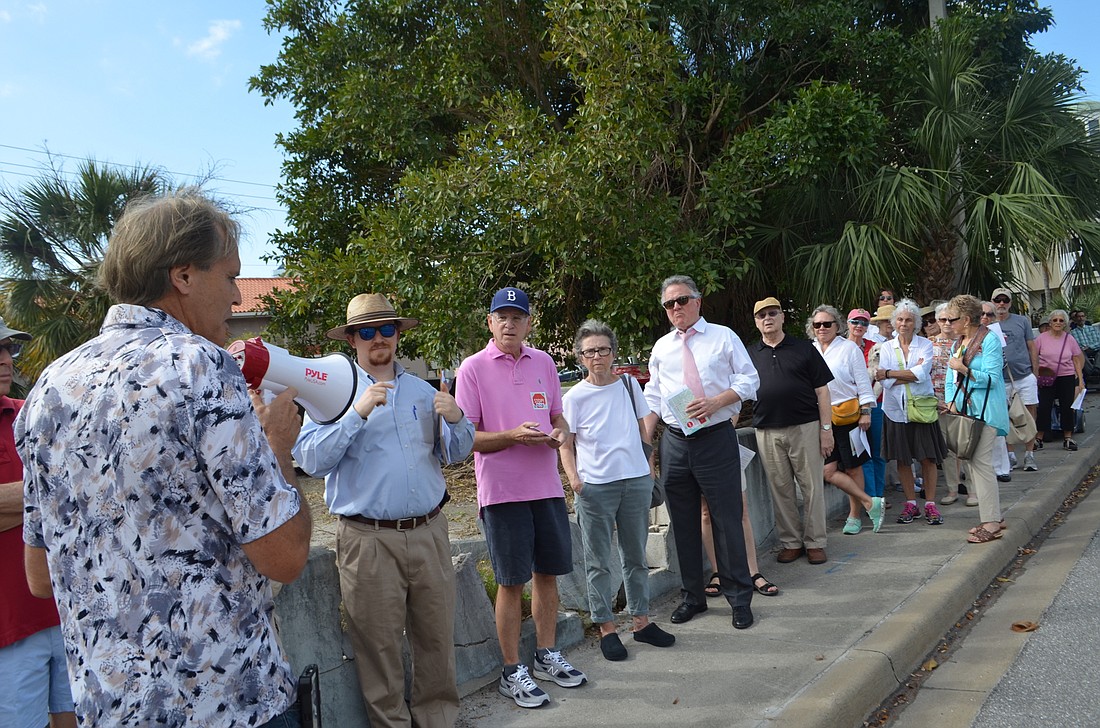- April 19, 2024
-
-
Loading

Loading

Just before noon Monday, Feb. 12, more than 40 residents assembled in a single-file line along Fruitville Road to listen to a man speaking through a bullhorn.
The man, Mike Lasche, is part of the steering committee for the activist group STOP. He was talking about one of STOP’s core issues: sidewalks.
STOP is asking the city to prioritize the creation of wider sidewalks, particularly downtown. The group frequently uses Fruitville Road as an example underscoring the urgency of its cause. The street, which separates downtown from the Rosemary District and Gillespie Park between U.S. 41 and U.S. 301, has sidewalks as narrow as 4 feet.
City staff agrees the situation is less than ideal. Although STOP is critical of the regulations that created the pedestrian conditions in downtown, Assistant City Engineer Daniel Ohrenstein said the city is more or less ideologically aligned with the resident group.
The city is considering a new design for Fruitville Road that would allow for sidewalks at least 10 feet wide. Ohrenstein said the current configuration of Fruitville Road dates back to the 1980s and prioritizes the driver experience over pedestrian comfort.
“They certainly weren’t as attentive to the needs of pedestrians and bicyclists back then,” he said. “The same things go for U.S. 41. A lot of (what we have to do) is correcting the errors of the past.”
The proposed Fruitville redesign could narrow a segment of the state highway from four lanes to two lanes — a controversial concept when first presented. Ohrenstein said that highlights restraints on the city’s ability to create wider sidewalks. If most of the public realm is dedicated to roads, that restricts land for sidewalks.
And although staff can ask builders to provide wider sidewalks, there’s no mechanism to force developers to comply.
“The biggest problem we come into contact with is limited right of way,” Ohrenstein said. “We can’t require that developers donate us land to build wider sidewalks.”
During the walking tour, STOP highlighted segments of Main Street and Palm Avenue as exemplary pedestrian experiences. Lasche highlighted the strengths of the 1300 block of Main Street, wide enough to accommodate outdoor dining and sidewalk furniture and still leave space for pedestrians.
“When you look down the street, what you see is lively,” Lasche said. “This is an enjoyable place to be.”
There may be a reason STOP sees Main Street and Palm Avenue as model streets — they’re just two lanes, which gives the city the ability to dedicate more right of way space to sidewalks. Ohrenstein said creating a similar atmosphere on U.S. 41 or Fruitville Road would be difficult, considering their status as major thoroughfares.
He said the city is looking outside of Sarasota as it searches for a model for Fruitville Road. He mentioned La Jolla Boulevard, in San Diego, as an example of a major thoroughfare that narrowed its roadway to create a more pedestrian-friendly environment, while adding roundabouts to maintain a similar capacity for traffic.
Supporters of STOP are asking the city to take a closer look at its regulatory power during a Feb. 22 meeting, held specifically to discuss sidewalks and building setbacks. Even subtle changes can help, STOP believes.
STOP steering committee member Kate Lowman highlighted a segment of Cocoanut Avenue near Palm Avenue, at the site of the new Art Ovation hotel. Although most of the area is relatively pedestrian-friendly, she said there’s no clear signal that people can keep walking through the hotel’s driveway area.
“It’s marked in a way that makes the cars feel they own it and the pedestrians feel they don’t,” Lowman said.
As the city prepares to vet a proposed form-based zoning code, residents are hopeful improved sidewalks will be woven into the city’s street network.